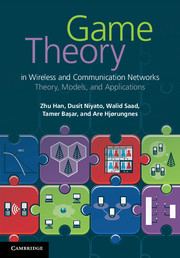Book contents
- Frontmatter
- Contents
- Preface
- 1 Introduction
- 2 Wireless networks: an introduction
- Part I Fundamentals of game theory
- 3 Non-cooperative games
- 4 Bayesian games
- 5 Differential games
- 6 Evolutionary games
- 7 Cooperative games
- 8 Auction theory and mechanism design
- Part II Applications of game theory in communications and networking
- References
- Index
8 - Auction theory and mechanism design
from Part I - Fundamentals of game theory
Published online by Cambridge University Press: 25 October 2011
- Frontmatter
- Contents
- Preface
- 1 Introduction
- 2 Wireless networks: an introduction
- Part I Fundamentals of game theory
- 3 Non-cooperative games
- 4 Bayesian games
- 5 Differential games
- 6 Evolutionary games
- 7 Cooperative games
- 8 Auction theory and mechanism design
- Part II Applications of game theory in communications and networking
- References
- Index
Summary
Auction theory is an applied branch of game theory that deals with how people act in auction markets, and it studies the game-theoretic properties of auction markets. There are many possible designs (or sets of rules) for an auction, and typical issues studied by auction theorists include the efficiency of a given auction design, optimal and equilibrium bidding strategies, and revenue comparison. Auction theory is also used as a tool to inform the design of real-world auctions, most notably auctions for the privatization of public-sector companies or the sale of licenses for use of the electromagnetic spectrum.
Mechanism design is a subfield of game theory studying solution concepts for a class of private-information games. The distinguishing features of these games are as follows. First, a game “designer” chooses the game structure rather than inheriting one. Thus, the mechanism design is often called “reverse game theory.” Second, the designer is interested in the game's outcome. Such a game is called a “game of mechanism design” and is usually solved by motivating players to disclose their private information. The 2007 Nobel Memorial Prize in Economic Sciences was awarded to Leonid Hurwicz, Eric Maskin, and Roger Myerson “for having laid the foundations of mechanism design theory.”
- Type
- Chapter
- Information
- Game Theory in Wireless and Communication NetworksTheory, Models, and Applications, pp. 221 - 252Publisher: Cambridge University PressPrint publication year: 2011
- 1
- Cited by



